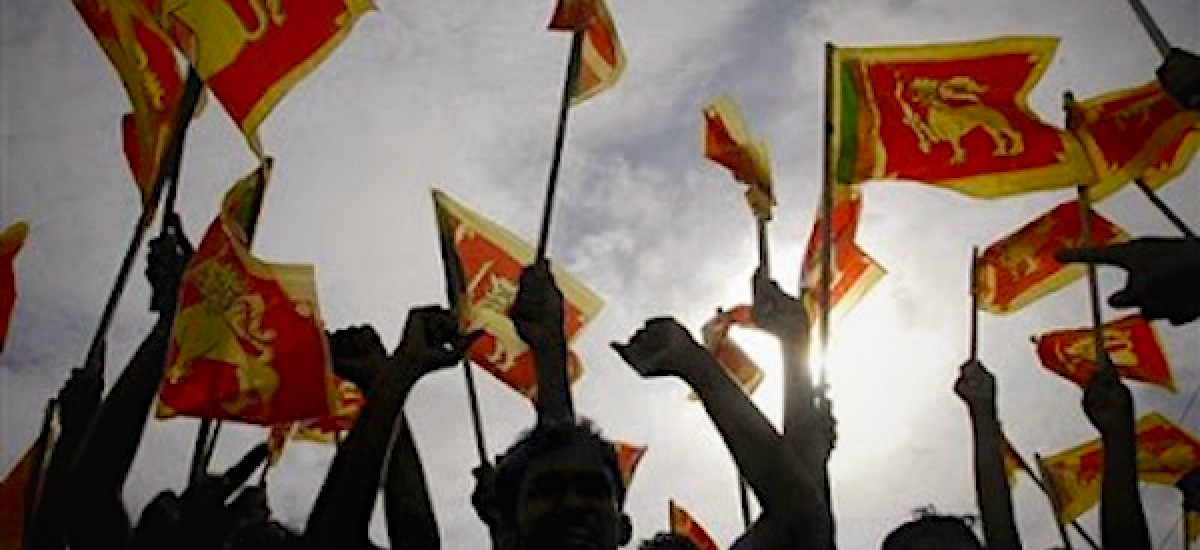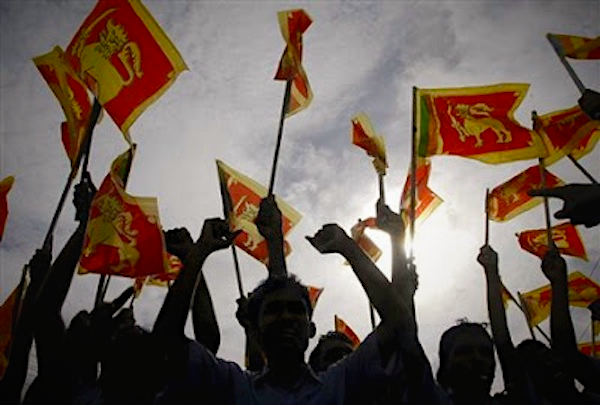Photo courtesy Sri Lanka Guardian
Much is being written nowadays about post-war Sri Lankan identity and the challenges of unity in diversity, among which are well-meaning interventions extolling the virtues of building a modernist, inclusive Sri Lankan nation that transcends narrow, parochial ethno-cultural identities. Given the fact that we completely and calamitously muffed the first opportunity to do so at the postcolonial historical moment, and fought a thirty-year ethnic conflict as a result, it ought to be strange that we should once again be resorting to this grand idea with such alacrity. That it is trotted out so uncritically and so often by patently well-intentioned, politically moderate and open-minded people – from the authors of the LLRC report to many political commentators and citizen journalists – demonstrates not only the pervasiveness of this idea in our political imagination but also the limits of that imagination.
One such intervention is the recent article by Kamaya Jayatissa, in which a fervent argument is made for the need to construct a nation called Sri Lanka from the fractured fragments of the war’s aftermath. The superficial attraction of this model, and the platitudinous sentiments that accompany it, can be seen in the way in which D.B.S. Jeyaraj reproduces Jayatissa’s article in his blog. Describing Jayatissa’s piece as a ‘clarion call’ for a new Sri Lanka, he compares it to the sentiments expressed in the Rev. W.S. Senior’s poem Call to Lanka. Nurtured, as Jeyaraj was, in the cradle of Anglican civility and civilisation that is S. Thomas’ College, I fully relate to David’s resort to Senior in a moment of inspiration, and I am glad that he is similarly uninhibited by what is now fashionable to regard as the ‘orientalist’ nature of Senior’s heartfelt feelings. Senior, as revealed even within the three short stanzas David has quoted, was very much an Englishman of his time. Schooled on Newbolt and Kipling at Marlborough and Oxford at the height of the Raj, his Anglicanism and his genuine love of Ceylon leavened the Victorian imperialism he was serving. In other words, he was discharging the white man’s burden, but in a nice way. Senior thus reflects a number of ideas that made up the liberal European orthodoxy of the time, among which was the notion that non-white peoples had to be tutored out of their tribalism so as to be ready for self-government in the future. But, because they share the same assumptions about deracinated nationhood, David’s wholly apt comparison of Jayatissa and Senior should give us pause.
Presumably because she was not setting out to address an academic audience, Jayatissa does not expressly set out a theoretical basis for her argument, but the ideological framework on which she relies is very clear, and perhaps unsurprising for someone educated at the Sorbonne and Sciences Po. In my view, her central ideological assumption, or to use the Rawlsian term, her ‘original position,’ is one that is associated with the theory of state-nationalism in the French Jacobinist tradition. I refer here not to the sans-cullotes in the historical sense, but to Jacobinism as it is understood by modern constitutional theorists to denote a reification of the nation-state in which both state and nation are defined in fundamentally unitary terms, and which is located within the broader tradition of the liberal-modernist Westphalian nation-state. This is apparent in the way she understands three of the key concepts of identity politics: ethnicity, the state and the nation. Despite attempts to nuance this approach with policy arguments about ‘multi-ethnicity,’ Jayatissa’s piece is almost a classic representation of how the Jacobinist approach to state form in multi-ethnic and multinational polities would result in a total negation of national pluralism (i.e., the existence of more than one nation within the territory of the state), not only as a matter of sociological reality, but also as a cardinal liberal value in democratic politics and constitutional law.
Positing the cause of post-war reconciliation as the opportunity and the moment to ‘[re]build a Sri Lankan identity,’ Jayatissa attempts to articulate a unifying state ‘ideology,’ one that she hopes the ‘younger generation’ will take up, that addresses the ‘psychological split’ between north and south. The tenor of the argument is that the nation is, and ought to be, something exclusively associated with the state (as in the hyphenated ‘nation-state’): this is the conclusion to be drawn from the celebration of ‘Sri Lankan-ness’ as a unifying concept and from many other observations that equate the nation with the state. The general implication of this is that for the Sri Lankan state-national identity to succeed as the principal device of post-war unity, sub-state national identities should enjoy no constitutional recognition. Indeed, these ‘somewhat irrational identities,’ as Jayatissa condescendingly calls them, should actively be discouraged because their existence threatens the construction of an ‘inclusive and homogeneous’ Sri Lankan identity.
The essential theoretical inadequacy of this approach is that it has no answer to two key questions that have been central to constitutional reform in Sri Lanka since before independence. The first is that it pretends to promote a conception of nationhood that is culturally neutral and founded on normative values and citizenship rights. This forced distinction between political culture (good, modern) and ethno-religious culture (bad, primordial) has been empirically shown to be fallacious even in the liberal democratic West, not least in France. It is in any case a complete non-starter in Sri Lanka, where the state is and has always been closely interlaced with the majority nation, the Sinhalese-Buddhists. A culturally neutral state is therefore not a viable assumption from which to theorise national identity in Sri Lanka, because that assumption fails to take into consideration the omnipresent potential for not merely homogenisation (which Jayatissa in fact endorses) but also majoritarian hegemony.
For similar reasons, the argument about secularism, which it is fair to presume is one that contemplates French-style laïcité rather than the more culturally contextualised Indian version, speaks to a socio-political environment that has little resonance and relevance to Sri Lanka. In other words, radical secularism is not the chief constitutional concern, and by attacking the delicate if inelegant balance reflected in Article 9 of the present constitution, would probably serve to reopen an unnecessary distraction, when the main objective of constitutional reform in regard to the post-war state lies elsewhere.
This then leads to the second problem with the Jacobinist model, which is about how sub-state nationalisms can be accommodated in a context in which the Sri Lankan Tamils continue to assert a distinct national identity. In a model that recognises only one national identity tied to the state (Sri Lankan/Sri Lanka), but which also notionally subscribes to the democratic principle of individual autonomy and choice, what happens when a group of individuals get together to claim a separate national identity, and demand recognition of it in political and constitutional terms? There can only be two responses to this within the conceptual parameters of the Jacobinist nation-state: either suppress the sub-state nationalist demand (in which case, it ceases to be democratic), or allow secession (because a nation can only exist as a state).
Either way, the Jacobinist model fails to address the main constitutional challenge of post-war Sri Lanka, which is the question of how, consistent with democracy, more than one sub-state nation can be given constitutional recognition, representation and autonomy, but in a manner that guarantees the unity of the Sri Lankan state. In this we need to look backwards to our own pre-colonial past as well as elsewhere to plurinational polities such as the United Kingdom, Spain and Canada, and indeed to models of constitutional asymmetry short of plurinationalism such as India.
Before Jacobinist thinking and the unitary state were institutionalised in nineteenth century Ceylon and appropriated by the majority Sinhala-Buddhist nation in the twentieth century, the form of ‘galactic’ or ‘mandala’ statehood that prevailed in the island, while hierarchical and encompassing, also allowed dispersed, pulsating and asymmetrical authority. In these pre-colonial conceptions of political organisation –which provided a unifying ideational coherence in the notion of Sinhalē, while allowing very substantial autonomy at the periphery – are to be found the nucleus of a constitutional settlement for Sri Lanka that is less anomalous with our past, and therefore more durable than the Eurocentric Jacobinist model. Once we have settled the sub-state national question within the framework of a united state, and secured the loyalty of constituent groups to the state on a basis of consent and persuasion rather than force and imposition, an efflorescence of Sri Lankan-ness will inevitably follow.
Naturally, just as much as questioning the Jacobinist constitutional model does not mean an affirmation of Bourbon France, seeking inspiration from the pre-colonial state does not denote some atavistic pining for the old Sinhalese monarchy. It means, rather, that in the democratic, civic, republican present, contemporary principles of constitutional organisation can be better developed if we pay more heed to the ‘usable past’. We have the historical experience of a state form that seems to have dealt with the question of plural collective identities and territorial autonomy far better than we have managed in recent times, because the obsessive anti-pluralism of the monistic nation and unitary state that characterises our postcolonial history was wholly alien to it. So while we may agree that Abbé Sieyès asked the right question in Qu’est-ce que le tiers état?, to answer it in terms relevant to Revolutionary France in relation to post-war Sri Lanka is to commit a fundamental category error.


